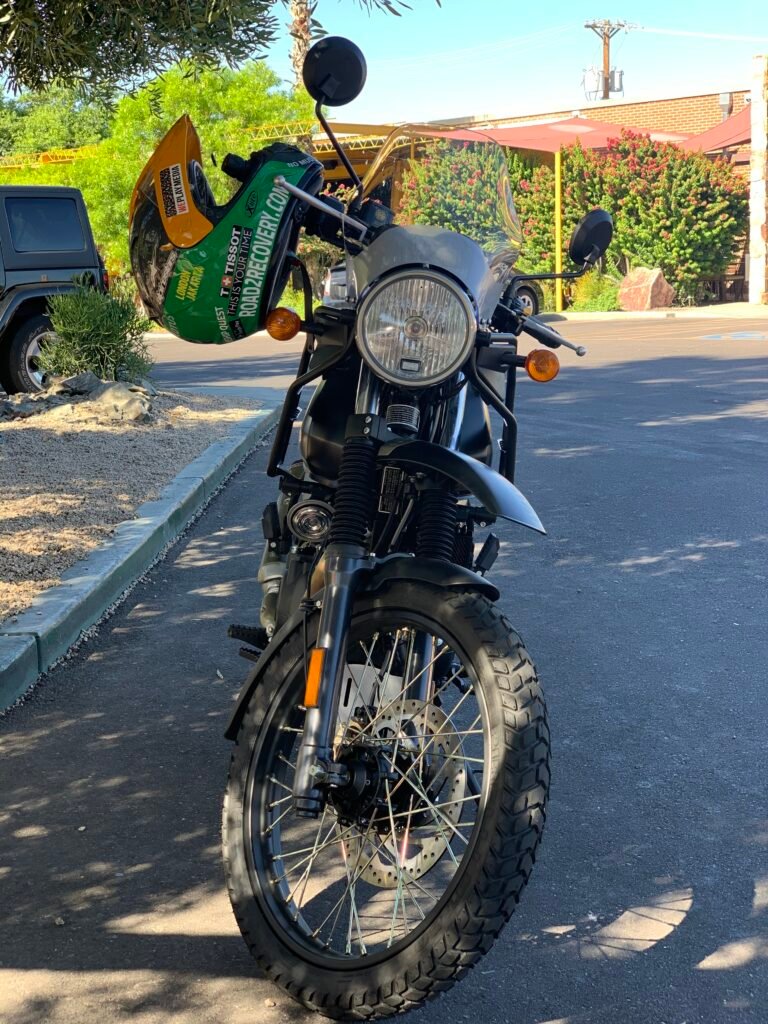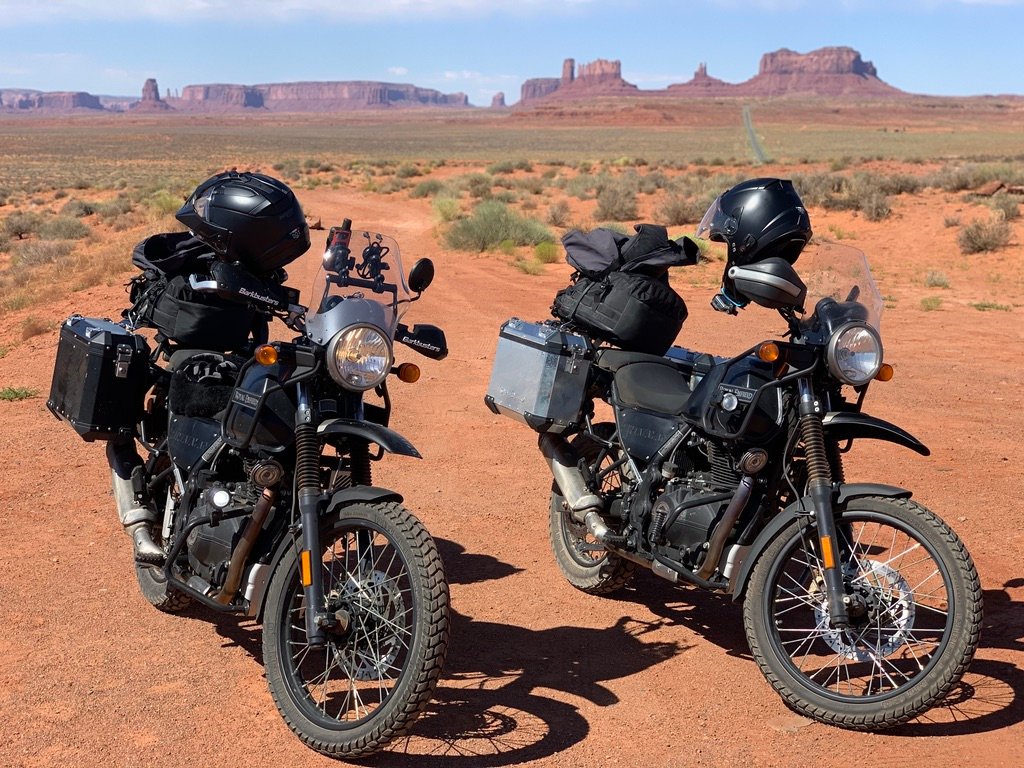
In the middle of the Coronavirus Lockdown, Declan and Graeme jumped on the Himalayan’s and rode them over 2500 miles through the Canyonlands of the South West USA. Read the article published down under here.

In the middle of the Coronavirus Lockdown, Declan and Graeme jumped on the Himalayan’s and rode them over 2500 miles through the Canyonlands of the South West USA. Read the article published down under here.
The red dust of the Utah Canyonlands blanketed our bikes, contrasting with the matte black paint, giving them a patina only an adventure can. As Declan and I parked up in the center of the alpine village of Vail, Colorado, kids on bicycles quickly swarmed around us, ignoring the Ferrari’s and Bentleys parked nearby. “I love your motorbike” yelled one kid, “it looks old fashioned”. It was then it struck me, Royal Enfield has managed to design and build a motorcycle that is the equivalent of a cute dog, in an even cuter sweater, being led by an even cuter girl. Everywhere we went on our 2500+ mile test ride, the bikes invoked attention from kids, adults and random passersby, sparking conversations which led us to recount the origins of the brand and the dual-purpose nature of the motorcycles we were riding.
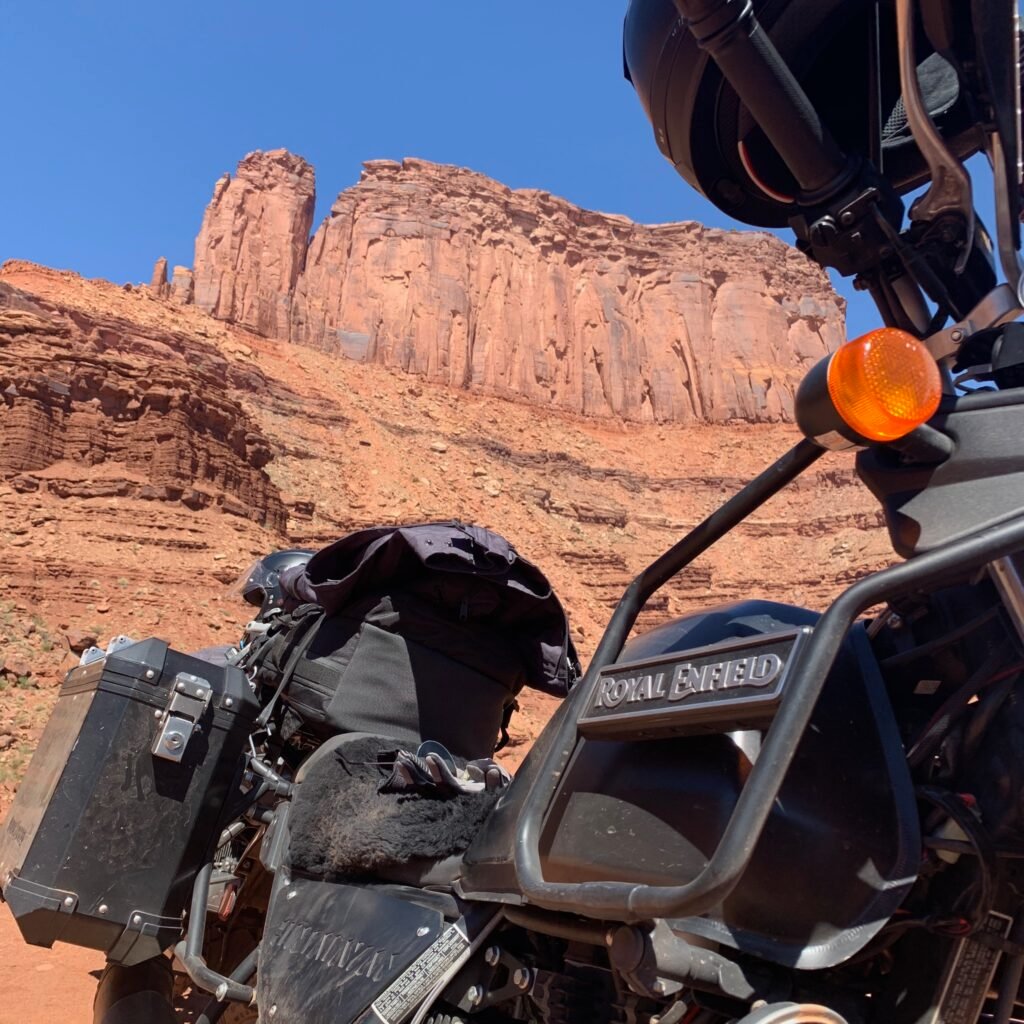
Of course, our accents, an Australian and an Irishman, added additional intrigue and prompted questions about our trip, what we thought of America, of politics and pandemics. We met some lovely people, who shared with us their local knowledge on everything from roads to restaurants and who, but for these two wheeled icebreakers, would have gone about their business and we would be lesser for the interactions.
To say the designers of the Himalayan got the fundamental aesthetics right is an understatement. They absolutely crushed it. The visual package is of a full-size adventure-oriented bike, part scrambler with long travel suspension, and part tourer with a clearly upright riding position and the fantastic OEM panniers. Unlike the alternatives in its class, the Himalayan is bereft of plastics, glossy cowls and pretention. It boasts protective steel frames around the tank, adorned with the classic Royal Enfield logo which adds to its retro appeal. The only visible plastic is the small infill side panels and front indicator mounts. The bike stands tall and purposeful. It is clear what it is, and importantly, what it is not.

Declan, a lifetime rider and sports bike aficionado, and I had first planned this test while we debated the virtues of various adventure bikes, using our Covid-19 lockdown time to plan a trip which would give us the opportunity to be socially distanced from the world around us, which was getting crazier by the day. The process of arriving at the Himalayan was an interesting one with budget, usability both on and off-road and lifetime cost of ownership, guiding the decision making.
Our job, over a couple of months of testing, was to run the Himalayans in every environment we could find, putting them to the test to discover what they are good at, to expose their weak points and to be able to communicate to you, how a Himalayan may fit into your riding life, if indeed we felt it was worthy of space in your garage.
To do this we spent a few weeks living with them in the city of Phoenix, Arizona, riding them to work, to the store, the local cafe and on a couple of extended day rides to some of the many lakes around the city. We took the opportunity to modify them as we sought fit. Adding crash bars, panniers, additional lighting, mounts for phones and GPS and generally preparing them for our longer 2500+ mile run to the Canyonlands of Utah and cooler climates of Colorado.
This proved to be an invaluable exercise. The Himalayan already clocks in as one of the best value bikes on the market with a sticker price of around $4500. As any of you who have tricked out a bike before will know, the base price is really the starting point for the real cost to escalate, as all the optional extras are applied. In the case of the Himalayan the entire luggage system including the mounting brackets is under $700, crash bars cost under $100, hand guards likewise under $100. On one of the bikes we decided to add every meaningful option available to us, including an ECU upgrade from PowerTronic which claims to boost horsepower and performance and we still struggled to spend more than $1300 all in …. for everything … including a sheepskin seat cover.
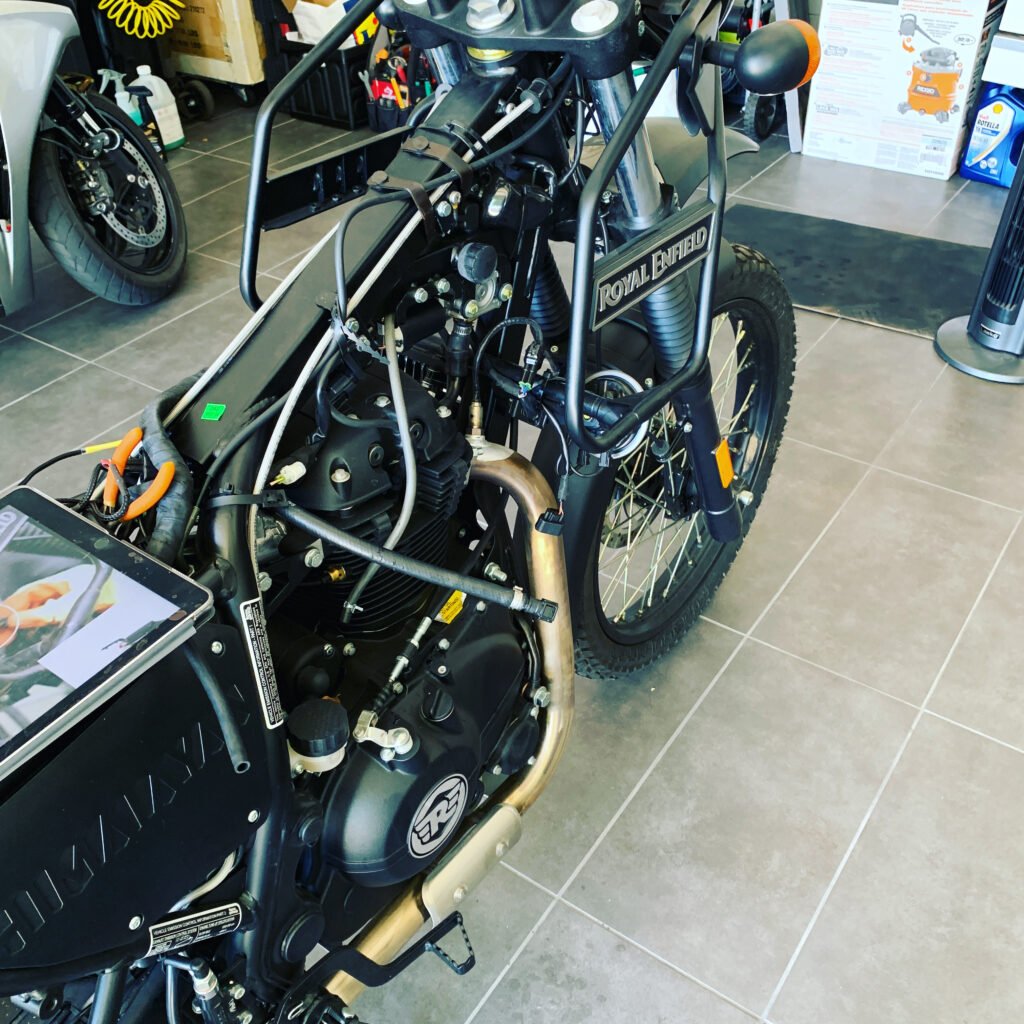
The Himalayans handsome appearance and stance is more than matched by its value. This is a bike you will struggle to waste money on. As we found in the rough stuff when things went wrong, the bikes stood up incredibly well to abuse and anything which did break, cost very little to replace.
Our impression of the bikes in the city was great. The torquey 411cc engine pulls well from the lights and you quickly move through the gears in city traffic. The bike handles brilliantly, soaks up bumps and potholes like a sponge, but never feels soggy. The upright riding position is comfortable, and you feel in control of the bike. If there is a weakness, it’s little things like the mirrors which are not great but adequate. Many people have criticized the brakes, but we found the anchors to be effective. They are made by an Indian subsidiary of Brembo and while they do not boast the familiar red calipers, they are clearly engineered well, the front and rear ABS seem to be effective, although I had only one occasion on road when it was activated.
Getting on and off the bike is easy without the panniers, with them on however the exercise does look less graceful, as you kick your leg up like a cabaret dancer and hop forwards or backwards to get said leg into place. Once mounted, the standard seat is comfortable and its gel substrate is effective at soaking up vibration, while the material keeps you well placed in the saddle. The tank is narrow and allows you to grip it firmly with your thighs making the bike feel sporty further adding to the feeling of control. The saddle height is low and allows shorter riders to comfortably place their feet on terra firma, At 5’10”, at lights, I could stand up and stretch and relieve the bum a little, this would prove to be welcome on longer rides.
As a city bike, the Himalayan would make a great commuter. It is a miserly consumer of gas and will easily get 50mpg from its long stroke single cylinder engine. In fact, it sipped fuel so slowly we had to remind ourselves to fill up the tank, especially on longer runs. The comfortable upright riding position gives you a great view of the road and its myriad of hazards, and the exhaust is loud enough to be heard without being obnoxious.

The Pirelli tires which come standard are brilliant. I say this because they provide you with a sense of comfort at speed into corners with no feeling that they will break traction. In the wet they shed water and penetrate standing water well. We drove through some torrential rainstorms where the road surface was flooded. Even at 50mph the tires never felt like they would aquaplane and remained firmly connected to the blacktop. We have not put enough miles on the bikes to really understand the wear patterns of the tires however, frankly, I don’t care about wear, I just want the best tires money can buy because that contact patch with the road is the most important 6 square inches of rubber you will ever find.
As we packed the bikes for our Canyonlands adventure, we loaded them up with tools, tire repair kits, compressors, luggage, camera gear, our drone while leaving plenty of space to carry water, as we would be taking our social distancing very seriously. I would estimate we added a good 80+ pounds to the bikes by the time we rolled on the throttle for our adventure.
On the highway the Himalayan gets along all day at 70mph. We had them going faster with the aid of a downslope and tail wind. Remember what I said at the beginning, it’s clear what these bikes are, and are not. High speed highway tourers they are not, but at 70mph, they hum along all day. When we hit more than a modest climb it necessitated a downshift to 4th and on steeper climbs down to 3rd. We never feel like the traffic was overwhelming us, just enjoyed the feeling responsibility and comfort, knowing that the cops hiding along the highway will need to pull someone else over.

In high cross winds, the bikes tracked true and felt solid. The combined weight of my bike, gear and I was easily 650 pounds and while we were buffeted with wind gusts, neither Declan or I felt we were being blown all over the road. The standard windshield worked well throwing the wind up and over my helmet. I had moved my windshield to the most upright position to accommodate the mouthing rack for the GPS and phone, Declan on the other hand left his in the lower position. My Nolan helmet with the peak attached never felt like it was getting tossed around.
The brakes also worked well under load and we were hugely impressed with the engine braking. The combination of the right gear selection and defensive riding makes for secure and comfortable riding and contributes to the control you feel over this motorcycle. When parked, we noticed the bikes intermittently make this funny little groaning noise, like an animal. We eventually concluded it was the ABS making the noise and contributing to the personality of the bikes and generating a laugh when it did.
Off road is really where the Himalayan shines. Even fully loaded these things are a blast to ride. On nice gravel roads we would “Toby Price it” getting along at 50 even 60mph. In deep sand, the torquey engine is like a tractor and plows you through. On really rocky trails, the only limitation we found was the ground clearance of the center stand. On one such trail I broke off the spring mounting post on the side stand, necessitating a track side fix with a zip tie.

We tacked the White Rim Trail in Canyonlands National Park, a 100+ mile 4WD trail that is not for the faint of heart or inexperienced off-road rider. What most people do in 2 days with 12 hours of riding we knocked out in 1 day over 10 hours. This was the ultimate test for the off-road ability of the bikes as the trail threw everything at us, with the exception of mud as it was over 100 degrees the day we were there.
I managed to crash three times and Declan twice. Our crashes exposed the weaknesses of the riders rather than the bikes. Had we tracked the right path we would have avoid the sand or rocks that sent us earthward. Once upright and with newfound respect for the terrain, we moderated our riding and managed to get through safely, albeit a bit bruised and battered for the experience.
When riding in a standing position I felt the handlebars were a little low for my comfort. Bar risers of an inch will fix that. Declan found it to be very comfortable, he is an inch or two shorter than me. The ABS is switchable; however, we didn’t read the instructions and couldn’t figure out how to disable it. Nonetheless on very steep descents the engine braking and ABS on the rear kept the bikes controllable, which was a good thing as there were often 500+ ft sheer cliffs just a few feet away. There were a couple of times when we would stop and look at the steep, rocky, lose surface of the trail, shake our heads and resign ourselves to the fact we had to ride it, as turning back was not an option. On these occasions the bikes performed better than we could have hoped for and gave us the confidence we needed to continue forward.
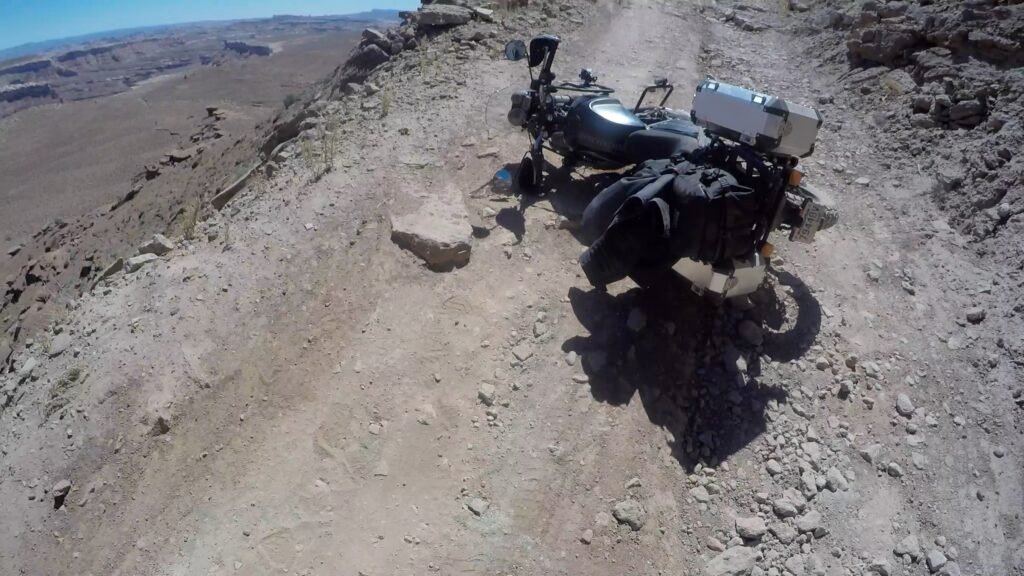
The OEM luggage fitted to the bikes deserves an honorary mention. These things are simply brilliant. They are strong, absorb all sorts of abuse, make it easier to pick up the bike when you drop it, they are adequately large without being stupidly big. The locks and hardware are great and work well. I was pleasantly surprised with this, as rugged adventure panniers often look like industrialized tanks bolted to the side of an otherwise svelte motorcycle. The Royal Enfield design is elegantly rugged and entirely fit for purpose. The plastic reinforcements on the corners are more than decorative, they are effective at shielding the metal from damage. The puck system of attachment makes putting the panniers on and removing them an exercise that can be accomplished in under a minute.
Two up riding, even when fully loaded was also put to the test. Declan picked up a pillion passenger for both highway and off-road sections to see how the addition of another person would change the balance and performance. His report was that the bike really felt no different, the engines torque profile adequately moved it along without any discernible change and the bike remained balanced and sure footed. The passenger reported a comfortable ride and the seat design provided a nice perch to view the scenery from.
So, where and what are the weaknesses of these bikes? Well after 2500 miles on all sorts of terrain, there really aren’t any weak spots that would tell me that this is a bike I would not want to own. Sure, the mirrors suck, the center stand could be redesigned to give more ground clearance, it would be great to have a 6th cog in the transmission for highway riding, but these are the only weak spots we could come up with. Sure it would be nice to have a little more power on tap, the benefit would be only felt on the highway at speeds which put you in ticket territory. Off road the performance is perfectly adequate and does not overwhelm you in any way.
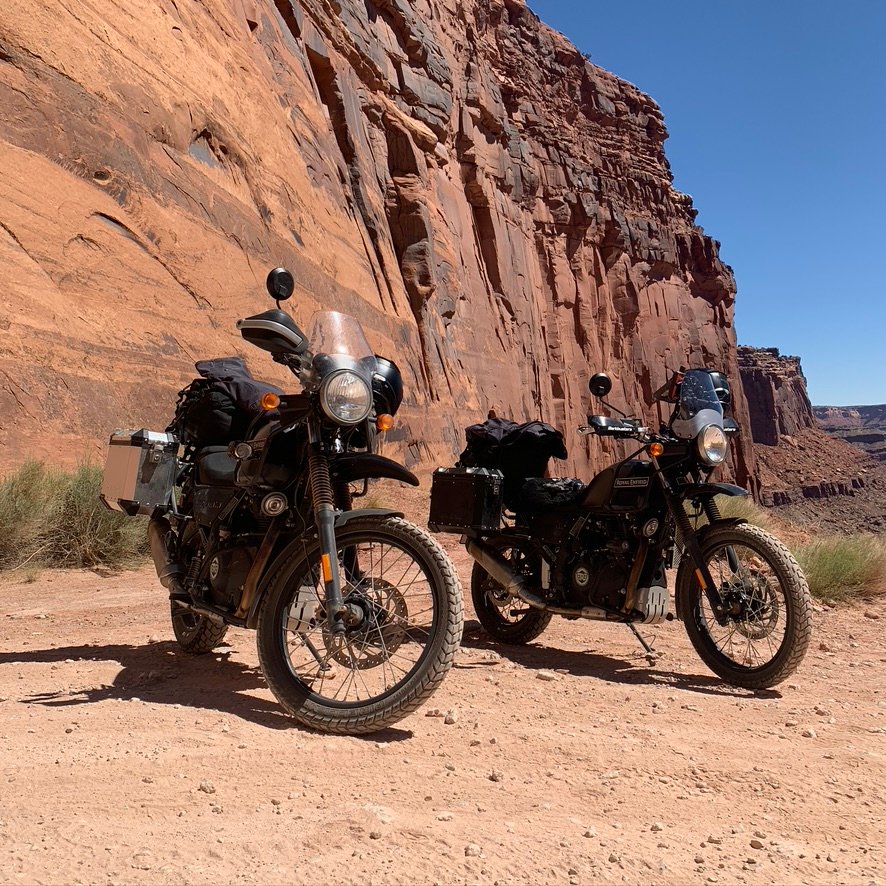
The Himalayans attract warm, affectionate comments from bikers and non-bikers alike. They are wonderful to ride on and off road, they sip fuel in an environmentally responsible way, they are great touring bikes and best of all they are cheap to buy, upgrade and fix, making adventure riding truly accessible without breaking the bank.
When you sit atop a Royal Enfield motorcycle, you do so on the storied history of the brand which dates back to 1901. This esoteric virtue is hard to put a finger on but feels special. They are not common bikes and you rarely see one on the road, so I guess that makes them somewhat cooler than riding a more common motorcycle.
As an adventure bike the Himalayan’s strength is its simplicity and rugged design. If you drop it you can comfortably pick it up on your own, you won’t break a $1000 plastic cowl and unlike some of the BMW 1200GS bikes we saw along the way, the Himalayan inspires confidence in the rider rather than fill them with fear. Fear of dropping it, damaging it and being stranded.
And that is the biggest take away for me. Meeting riders of the big adventure bikes I have long admired, exposes a dichotomy of feeling in the owners. While they look like they can go anywhere and probably can, the riders rarely do because they become fearful that the bike, and terrain will exceed their ability. On a Himalayan, you really do feel like you can go anywhere, ride any trail or road and truly live the adventure that exists in your mind’s eye. What good is an adventure bike if you are too nervous to take it on an adventure?
As I reflected on our trip, I recall saying to Declan on more than one occasion that the bike was like a mountain goat, it could go up and down anything. With that thought I will simply summarize, The Royal Enfield Himalayan is indeed a G.O.A.T. – the Greatest Of All Time in its weight class.
You can also see the route map at this link
One of the criticisms of the Himalayan is the lack of power and top speed. The 411cc engine delivers 24.5 horsepower (18.02KW) at 6,500 rpm, which is somewhat meagre by adventure bike standards. To boost performance, Race Dynamics, an Indian company developed the ‘plug and play’ PowerTronic kit which remaps the ECU controlling both fuel & ignition to deliver optimal performance & throttle response throughout the rev range.
On the web site (see link below) they claim the process of installation takes around 40 minutes, which may be true if you are a professional installer and have done it a dozen times before. However …as I am neither a professional installer, nor had I any experience fitting such a equipment, my install took considerably longer.
If you are contemplating doing this on your own I expect you need to carve out half a day during which time you will spend an hour or so looking helplessly at bits and pieces of motorcycle, about 40 minutes figuring out own to remove the gas tank (although I will share the tips to expedite the process here) and a few hours wrestling with connectors, routing cables and praying you didn’t mess anything up.
The PowerTronic people have done a great job with the product. The harness looks great, is well made and the component parts look fit for purpose, while the packaging looks like Apple had a hand in its design. The instructions are hosted online and a quick QR code scan takes you to the document.
I found the instructions easy to follow however I want to share a few tips with you.
First when you remove the gas tank, be sure to remove the plug from the fuel pump (right side) at the same time you remove the fuel pipe. This plug is tucked up behind the fuel filter. It’s best accessed by laying on your back and looking directly up. Other than that the fuel gauge connector is accessed from the left side and the vacuum hoses slide off easily.
Another tip, there is a separate lead which has fittings at both ends. It was not immediately obvious what this was for. It is the oxygen sensor override and it is independent of the rest of the harness.
When routing the harness, try and tuck it on the underside of the existing wiring running along the frame. If you put it to the side, it will hinder the replacement to of the tank.
Make sure you leave enough length in the harness in the under seat area so you can comfortable locate the orange “brain” of the package. I initially didn’t and had to go back and cut cable ties to free up some more slack so i could comfortably maneuver the box to fit.
The fuel injection connector is a bitch to get at – you have to peel back the rubber cover to expose the connector, same goes for the Throttle Position Sensor (TPS)
I added the accessory map switch which gives you the option to toggle between Map 1 (pretty much stock) and Map 2, the enhanced map. I am glad I did. It says in the instructions you may have to recalibrate the TPS. I didn’t pay too much attention to that bit until I test rode the bike. In Map 2, as I rolled off the throttle when coming to a traffic light the engine would cut out. When I toggled back to Map 1, the problem was solved.
In order to reset the TPS you need to download a program and follow the steps you will find online (see link below) You then connect a PC based laptop (not Mac) to the PowerTronic unit with the provided cable and go through the steps of recalibrating the TPS, which is pretty simple but a pain in the ass.
As for the result of all this effort and expense? Yes the bike feels more responsive, it seems to get up and go quicker, rev faster and hard. I haven’t had the chance to really wind out out, but I have to say the results are noticeable.
Would I recommend you upgrade your Himalayan? Yes for the money it is worth it. However before you do, get a good nights sleep, block out half a day and while you are at it, you may want to consider adding an accessory power harness to your bike (USB / Socket) which is much easier to do with the tank off an allows you to run the wiring discretely and securely along the frame.

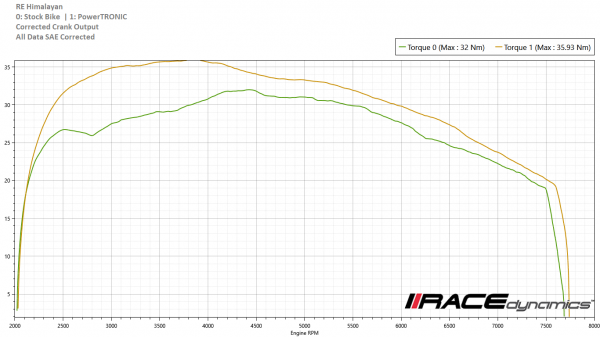
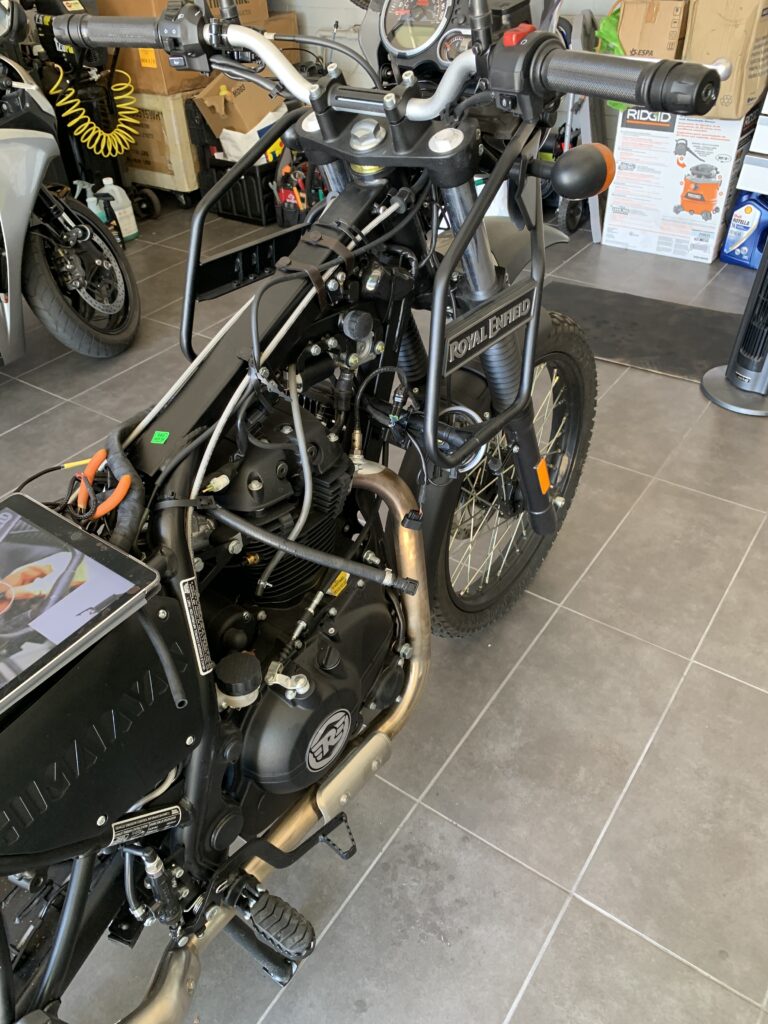
https://powertronicecu.com/product/powertronic-royal-enfield-himalayan-2017-2019/
When you are living through the worst pandemic since the Spanish Flu and are locked down in a curfew mandated by rioting and looting, following the tragic murder of George Floyd at the hands of the police, the thought of escaping becomes increasingly appealing. To quote the great Kiwi explorer Sir Edmund Hilary, “let’s get the fuck out of here hey Cuz”.
My mate Declan, a motorcycle riding Irishman and I began to plan a trip which would start in Phoenix Arizona and take us deep down into Mexico through Baja California. Along the way we hope to avoid getting the coronavirus, not be robbed, avoid all folks involved in the drug trade and basically not be killed, maimed or injured.
As we would both be riding Himalayan’s we have been using our time wisely, watching Tiktok videos of girls doing that stupid dance, devouring the full season of Tiger King and developing conspiracy theories of what happened to Carol Baskin’s husband. Shopping on eBay and Amazon also became a bit of an obsession as we farkled up the bikes in preparation for the trip. You can check out our farkling videos here.
Why Mexico? I’m glad you asked. You see it’s land as timeless as it is old. A land of piñatas, of margaritas, sombreros, murderers and rapists (well some may be good) if you believe Donald Trump. It’s a country I have explored before in my 1974 Kombi van back in the day and it has become my favorite country in the whole of Mexico.
Our trip will take us deep into the Baja Peninsula, through San Filipe, down to Loreto, to La Paz and then to Los Cabos San Lucas. One of the best things about traveling during these uncertain times of uncertainty, is that there will be fewer Americans and more Mexicans. Well not that there will be more Mexican’s, but the Mexican to American ratio will be way lower than it would be during say, Spring Break. Not this last Spring Break of 2020 which was impacted by Covid19, but say 2019 Spring Break where the American to Mexican ration was dreadfully high.
The absence of drunken American tourists can not be over estimated or understated when you are carving out an adventure riding expedition such as this. For one thing the Mexican locals should be happier to see us, embracing our presence warmly with hugs, cheers and enthusiasm normally reserved for birthdays, cincoanera or the death of a particularly nasty cartel member. It will also provide us with the opportunity to delve into the Mexican culture and customs without having some loudmouth Sepo sucking a gallon of beer through a snorkel.
So that’s the plan. On or around the 2-5 of July we will set off on our Himalayans and venture south of the border. Stay tuned and check out our preparation videos which we will be posting over the next few weeks.
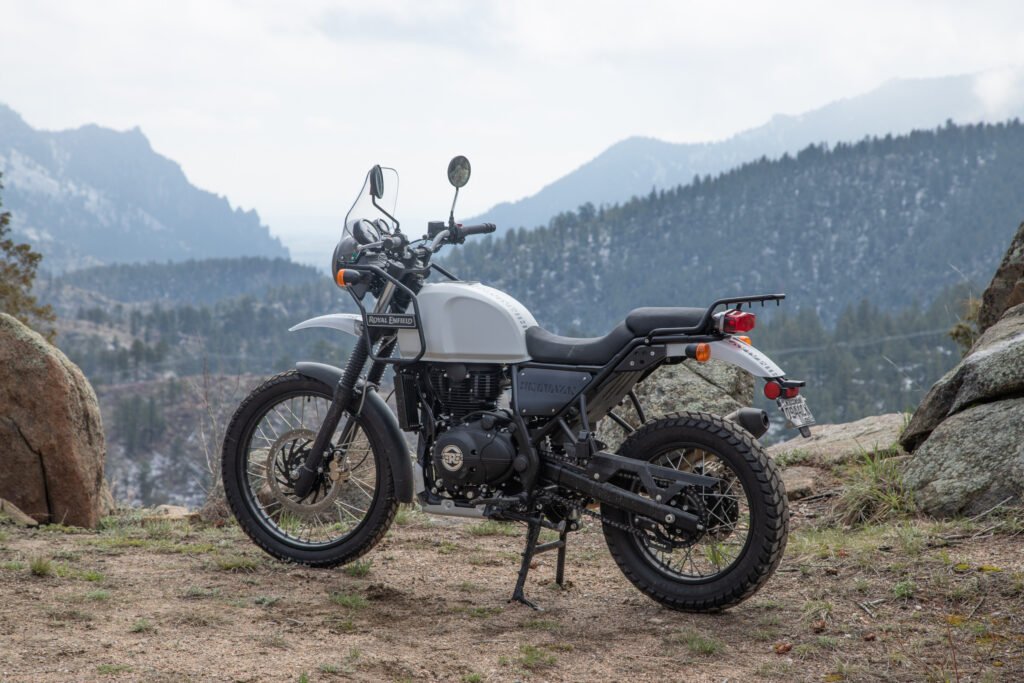
25 May 2020
Having spent weeks in a Covid19 lockdown and researching a trip from Phoenix to Cabo San Lucas and back, I reached out to the Royal Enfield team to see if they would be kind enough to lend me a couple of bikes for the trip. I would film the trip, write extensively about it and create a resource for other people like me who may be interested in taking the small leap ownership leap. With an affirmative confirmation, the trip was on and we began to plan.
The dealership experience to be honest was good and to the credit of the team at GoAZ they tracked down a bike from one of their other dealerships and transferred it to Scottsdale for me. The pickup was simple and easy and required zero interaction with anyone other than getting the keys. There was no explanation about the bike, no instruction or advice on how to run it in, simply a “bring it back for an oil change at 600 miles” and a “see ya” and I was off.
In contrast to, say a BMW 650GS and 1200GS, the Himalayan is a significant departure back through the ages. The feature list is short, the controls simple and the sound of the engine somewhat agricultural by comparison. However rather than in a negative way, the Himalayan feels nicely comforting, like a bike you knew from days gone by. It provides you with all of the things you need and literally nothing you don’t.
After swinging a leg over and firing it up, I was on the road. The bike pulls well in the first couple of gears which are short and require rapid shifting to third. The engine feels torquey and strong for a 411cc single cylinder lump. The gear changes are seamless and the clutch pressure is gentle. The riding position is fantastic, upright and comfortably confident, you feel in command of the bike rather than the bike being in command of you, as was my experience on the behemoth BWW1200GS. It is very ‘flickable’ and kind of sporty in a ‘short of breath’ kind of way. It has more in common with my old CRF250 than I expected.
I noticed a vibration as you get up through the gears and up towards the 60mph range, nothing bad, you just feel the bike doing your bidding as you roll on the power and stretch its legs. The Pirelli tires which come standard off good grip and a really nice balance of off road meat and quiet confident street manners.
The instrument cluster is old school analog however offers a nice little LED screen which provides you with a gear indicator, helpful little reminders like the side stand being down, ambient temperature which seems to run a little high and a cool digital compass which gives you a read out of direction and a helpful arrow which points true north. I wish they had have gone the extra mile and included an accessory power outlet or USB to keep your phone charged.
A common complaint I have heard is the poor performance of the front brakes. A dithering snowbird who had failed to return north before the summer provided me with the opportunity to test them as she pulled out in front of me while wincing and peering over the steering wheel of an old Illinois registered Mercedes. The bike dived a bit under hard braking however it felt solid and effective The bike and my 200lb frame pulled up quickly and without any rear end deposits.
As I rode the long way home, I was already planning the farkles which would be added to it in short order. By the time I reached the house, my mouse finger had developed an anxious twitch and I was on eBay within minutes of arrival.
The plan was to gear the bike up for the Baja run. I would be adding protection to the bike in the form of all manner of aluminum shrouds, crash bars, GPS mount and of course the rear panniers to carry gear. While some reviews had commented about the rear load carrier being flimsy and requiring upgrade, my first impression was it was solid as a brick shithouse. I purchased an expansive mounting plate which would make it easier to strap down a bag or even mount a top box should I feel the need.
A later trip to the local cafe revealed that the bike not only rides well, but is a quirky addition to the usual line up of plastic shrouded machines. The Himalayan stands out for all of its nakedness, the tank sided crash bars look purposeful and the bike just screams adventure when standing still. It looks comfortably out of place in the parking lot, like a bushman who has come to town for a visit, but can’t wait to get back to the land. Perhaps its differences make it the conversation starter it is. Over the course of 30 minutes I had explained its origins and purpose to no fewer than 7 people, a new record, considering my way more expensive Harley, my aggressive looking Triumph Tiger or my cute little Vespa all look pedestrian by comparison.
Now with 48 miles on the odometer, my initial reaction is that there is no signs whatsoever of riders remorse. I am very happy with the bike and I think it likes me too. Let’s hope that the relationship continues to blossom as we both prepare for the upcoming trip south of the border and the asphalt is replaced with dirt and gravel roads.
Graeme Warring @graemewarring
